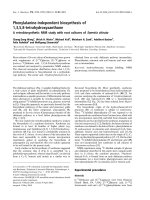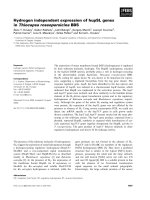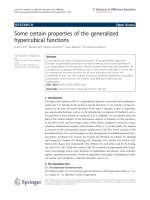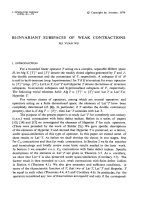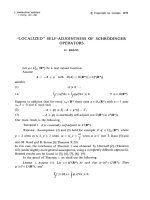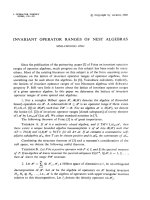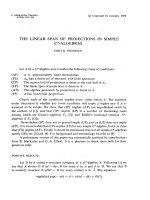Báo cáo toán học: "Linearly Independent Products of Rectangularly Complementary Schur Functions" doc
Bạn đang xem bản rút gọn của tài liệu. Xem và tải ngay bản đầy đủ của tài liệu tại đây (102.99 KB, 8 trang )
Linearly Independent Products of
Rectangularly Complementary
Schur Functions
Michael Kleber
Department of Mathematics
Brandeis University
Waltham, MA 02454
Submitted: 11 September 2002; Accepted: 16 September 2002.
MR Subject Classification: 05E05
Abstract
Fix a rectangular Young diagram R, and consider all the products of Schur
functions s
λ
s
λ
c
,whereλ and λ
c
run over all (unordered) pairs of partitions which
are complementary with respect to R.
Theorem: The self-complementary products, s
2
λ
where λ = λ
c
, are linearly inde-
pendent of all other s
λ
s
λ
c
.
Conjecture: The products s
λ
s
λ
c
are all linearly independent.
1 Introduction
The Schur functions s
λ
,whereλ is a partition or its graphical representation as a Young
diagram, play a pivotal role in the theory of symmetric functions and its many applica-
tions. The literature abounds with linear identities among products of two Schur func-
tions, many of which follow from expressing s
λ
as a determinant of a certain matrix,
to which the Pl¨ucker relations are readily applied. This paper instead presents a linear
independence result among some products of pairs of Schur functions.
Schur functions are indexed by partitions λ = λ
1
, ,λ
r
of all integers n ≥ 0; we
order the parts to be weakly decreasing and consider the partition to end with an infinite
tail of 0’s, which we are free to omit. We identify λ with its Young diagram, stacked rows
of λ
1
, ,λ
r
boxes, and write λ ⊆ µ if the diagram of λ sits inside that of µ, i.e. if λ
i
≤ µ
i
for all i.Ifwefixana × b rectangular Young diagram R = b, ,b = b
a
, then for any
λ ⊆ R,theboxesinR which remain when λ is removed from the upper left corner can
be rotated 180
◦
to get a new partition λ
c
, the complement of λ with respect to R.For
example, if R = 4
3
= and λ = 421 = then λ
c
= 32 = .
the electronic journal of combinatorics 9 (2002), #R39 1
We work in the ring Λ of symmetric formal polynomials in infinitely many variables
x
1
, x
2
, , of which the Schur functions {s
λ
} form a linear basis. The structure constants
of the basis, those c
ν
λµ
such that s
λ
s
µ
=
c
ν
λµ
s
ν
, are nonnegative integers called the
Littlewood–Richardson numbers. For example, in Λ:
= + +
= + +
= + +
=
(1)
These are precisely the four distinct products s
λ
s
λ
c
where R is the 2 × 2 rectangle. In the
fourth line λ = 22 and λ
c
is the zero partition 0, whose diagram is empty and whose
Schur function s
0
is 1 ∈ Λ.
Note that the products in (1) are easily seen to be linearly independent. Each of the
first two contains a basis element (s
4
and s
1111
, respectively) which appears nowhere
else. We immediately know that these products cannot show up in any linear dependence;
in this situation we say that some Schur function is a witness to the linear independence of
the product in which it appears. Once the first two products are dropped from consider-
ation, the third has two witnesses to its linear independence from all remaining products;
once the third is dropped, the fourth product has a witness as well.
The theorem will be proved by constructing a witness for each self-complementary λ,
as in the above example (if the rectangle’s dimensions are both odd, then for λ and λ
c
that
differ only in which contains the center box of R). The strong form of the conjecture is
that the above procedure of successive elimination via witnesses always proves the linear
independence of all the products.
Acknowledgements
This work was inspired by Mark Adler, who in January 2001 asked me whether some
statement along the lines of the theorem might be true. His interest was in unique repre-
sentability of certain special elements, the “τ-functions”, of the vector spaces
λ=λ
c
s
λ
.
These τ-functions are solutions to the finite Pfaff lattice and relate in some special cases
to Jack polynomials. For context see [1], though in the end the theorem was not needed
in general.
I posed the conjecture as an open problem during the “Symmetric Functions 2001:
Surveys of Developments and Perspectives” NATO ASI in June–July 2001, a workshop
that was part of the Isaac Newton Institute’s programme “Symmetric Functions and
Macdonald Polynomials;” my thanks to the organizers for inviting me to participate.
Thanks also go to Anders Buch for his Littlewood–Richardson Calculator and to Sara
the electronic journal of combinatorics 9 (2002), #R39 2
Billey for a hefty chunk of computer time to run it. The work prior to July 2001 (at MIT)
was partially supported by an NSF Postdoctoral Research Fellowship.
2 Theorem
Fix positive integers a and b,andletR be the partition b
a
, whose Young diagram is an
a × b rectangle. We take all complements with respect to R,andsayλ ⊆ R (and s
λ
)is
self-complementary if λ = λ
c
.Ifa and b are odd, there are no self-complementary λ.In
this case we will say λ is almost self-complementary if λ and λ
c
differ only in which one
contains the central box of R.
Theorem. The squares of the self-complementary Schur functions, s
2
λ
for λ = λ
c
,are
linearly independent of all other products s
µ
s
µ
c
for µ ⊆ R. If the dimensions of R are
both odd, the products s
λ
s
λ
c
for λ almost self-complementary are linearly independent.
By way of proof, we show that for each such λ there is another partition π which acts
as a witness to the linear independence: s
π
appears in the Schur function expansion of
s
µ
s
µ
c
if and only if µ = µ
c
= λ. First we define a new family of notations for partitions.
Definition. Let c and d be nonnegative integers, and let w be a word of length c + d
consisting of the letters h and v appearing c and d times, respectively. Let λ be a partition
with at most c parts larger than d.
1. The w-decomposition for the Young diagram of λ partitions the diagram into c + d
pieces. The ith piece is part of one horizontal row or vertical column, depending
on whether the ith letter of w is an h or a v, respectively. It begins with the
upper-left-most box not contained in any previous piece, and extends right or down,
respectively, to the end of the diagram.
2. The w-notation for λ is the c + d-tuple of integers λ
w
=(λ
w
1
, ,λ
w
c+d
), where λ
w
i
is the number of boxes in the ith part of the w-decomposition.
3. The w-ordering on partitions is the lexicographic ordering on their w-notations.
For example, Figure 1(a) depicts the w-decomposition of µ = 5411 with w = hvvh;
we see that µ
w
=(5, 3, 1, 2). The w-ordering has the following useful property:
Lemma. Fix a word w as above, and take two partitions with w-notations µ
w
=
(µ
w
1
, ,µ
w
c+d
)andν
w
=(ν
w
1
, ,ν
w
c+d
). Let π be the partition with π
w
i
= µ
w
i
+ ν
w
i
.
Then s
π
appears in the Schur expansion of s
µ
s
ν
, and it is the maximal partition (in the
w-ordering) to appear.
Proof. We show that s
π
appears in s
µ
s
ν
by presenting a Littlewood–Richardson tableau
of shape π/µ and content ν. This is straightforward: if the ith letter of w is an h (or v,
respectively), then we extend the ith part of the w-decomposition of µ horizontally (or
vertically, respectively) by ν
w
i
boxes. These new boxes are filled with the row numbers of
the electronic journal of combinat orics 9 (2002), #R39 3
111
222
33
44
111
2
2
2
3
3
4
4
(a) µ = 5411 (b) ν = 3322 (c) π = 8522211
Figure 1: w-decompositions for w = hvvh, illustrating the lemma.
the boxes in the ith part of the w-decomposition of ν.Itiseasytoverifythattheabove
algorithm maximizes each π
w
i
in turn, so π is w-maximal.
See Figure 1 for an illustrated example of the proof. We take w = hvvh. In (a) and
(b) we see the w-decompositions of µ = 5411 with µ
w
=(5, 3, 1, 2) and of ν = 3322
with ν
w
=(3, 3, 3, 1); each box in ν is labelled with its row. In (c) we see the π such that
π
w
=(8, 6, 4, 3) = µ
w
+ ν
w
; as a partition π = 8522211.Theboxesinπ/µ are filled
with the same numbers as the corresponding pieces of the w-decomposition of ν from (b),
giving a Littlewood–Richardson tableau.
If the word w is hh h,thew-decomposition just breaks λ into its rows, and the
lemma reduces to the familiar fact that s
µ+ν
is the maximal term appearing in s
µ
s
ν
in
the dominance order. A word of all v’s does the same for reverse dominance order, and
other words somehow interpolate between the two.
Proof of Theorem. Assume first that both dimensions of the rectangle R are even; this is
the case in which the proof is clearest. Let c = a/2andd = b/2 and pick any word w with
c h’s and d v’s, as above. We will determine the w-maximal partition π that can appear
in any product s
µ
s
µ
c
for µ ⊆ R. By the lemma, we must maximize µ
w
1
+(µ
c
)
w
1
.Wedoso
by maximizing each of µ
w
1
and (µ
c
)
w
1
independently: the w-decompositions of µ and µ
c
each begin with an entire row or column of the rectangle (where w begins with an h or
a v, respectively). Continuing inductively, we maximize each µ
w
i
and (µ
c
)
w
i
in turn; they
are independent and equal, because the ith pieces of the corresponding w-decompositions
are exchanged by rotating the rectangle 180
◦
. We conclude that µ = µ
c
.
Thus the w-maximal s
π
appears in s
2
λ
,whereλ is the w-maximal self-complementary
partition, and in no other s
µ
s
µ
c
. The map from words w to self-complementary λ is a
bijection. Each such λ is determined by the path of length c + d running from the upper-
right corner to the midpoint of the rectangle, separating λ from its complement. The ith
letter in the corresponding word w is h or v depending on whether the ith step in this
path is (confusingly) vertical or horizontal, respectively. See Figure 2 for an illustration.
Now assume that one dimension of R is odd. The above map from words w (with
c =
a−1
2
or d =
b−1
2
) to self-complementary λ still provides the proof. By the time the
last step of w that heads in the even-length direction is read, the maximizations fix the
boundary between µ and µ
c
and again they are equal. Finally, if both dimensions of R
the electronic journal of combinatorics 9 (2002), #R39 4
q q
µ
µ
c
q
µ
µ
c
q
µ
µ
c
q
q
µ
µ
c
❄✛✛
❄✛
Figure 2: Here R is 4 × 6 and we pick w = hvvhv. At each stage we assign boxes of R
to µ or µ
c
to make successive rows or columns as long as possible, depending on whether
the corresponding letter in w is an h or v respectively. Note how the letters in w give the
µ-µ
c
boundary: h =
❄
, v =
✛
.
are odd and λ is almost self-complementary, then the final maximization step leaves us
free to assign the central square of R to either µ or µ
c
.
3 Conjecture
A natural result that would subsume the theorem is the following:
Conjecture (weak version). Fix a rectangle R. The products s
λ
s
λ
c
are all linearly
independent.
The set of products here is of course parametrized by unordered pairs (λ, λ
c
)comple-
mentary in R. But the witnesses that appear in the above proof show something much
stronger than linear independence, and it too has a natural extension:
Conjecture (strong version). Fix a rectangle R, and define the sets:
P
0
= {s
λ
s
λ
c
} as above,
W
i
= {s
λ
s
λ
c
∈ P
i
|∃π : s
λ
s
λ
c
is the only product in P
i
containing s
π
},
P
i+1
= P
i
\ W
i
.
Then some P
i
is empty.
In other words, if we take the set of all products s
λ
s
λ
c
and iterate the operation “elim-
inate any products which can now be proved linearly independent by some witness s
π
,”
then we eventually eliminate all products. This is equivalent to the statement that with
appropriate orderings of the set of products and Schur functions, the matrix expanding
the products in the Schur basis is upper triangular.
Note an interesting difference between the weak and strong versions of the conjecture.
Verifying linear independence as in the weak version requires, a priori, knowing the actual
values of all of the Littlewood–Richardson coefficients c
ν
λλ
c
. The strong version only makes
claims about which of these coefficients are nonzero. The collection of triples of partitions
{(λ, µ, ν) | c
ν
λµ
=0} consists of all integer points in some cone, according to the Saturation
Conjecture, now a theorem of Knutson and Tao [2]; moreover the minimal set of linear
inequalities defining the cone is now known [3]. The strong version of the conjecture, if
true, follows from this set of linear inequalities.
the electronic journal of combinatorics 9 (2002), #R39 5
The remainder of this section gives evidence supporting this conjecture: computer
verification for small rectangles, proofs in some special cases, and the beginning of a sadly
incomplete inductive proof. Finally we mention a few failed attempts at generalization.
Computer observations
The strong version of the conjecture has been verified by computer, using Anders Buch’s
Littlewood–Richardson calculator, for all R fitting inside the 8 × 8or7× 9 rectangle.
For a sense of scale, the 8 × 8 calculation involves 6470 products, and they are linear
combinations of 395,377 distinct Schur functions (out of the 487,842 Schur functions of
degree 64 whose partitions fit in a 16 × 16 box).
The computer results confirm that the conjecture still holds if we require the witness
s
π
to always have coefficient one. That is, with respect to some ordering, the matrix
writing the products in the Schur basis appears to be upper unitriangular.
The theorem is the statement that the set W
0
contains all of the self-complementary
or almost self-complementary products. According to the computer calculations, these
appear to be the entirety of W
0
.
Quick Proofs for 1 × b and 2 × b
When R is a single row (or column), the conjecture is checked easily, e.g.:
= + + +
= + +
= +
=
Here we used that s
j
s
k
=
s
j+k−i,i
for i =0, 1, ,min(j, k).
We can also give explicit witnesses for the 2 × b case. To fix notation, let us always
choose λ = λ
1
,λ
2
to be larger than λ
c
,sothatλ
1
+ λ
2
≥ b. We partially order
the products s
λ
s
λ
c
by increasing values of λ
1
+ λ
2
; note that this ordering begins with
the cases λ
1
+ λ
2
= b, which holds precisely when λ = λ
c
. The general witness for
λ is π = 2λ
1
− λ
2
,λ
2
,b− λ
1
,b− λ
1
. There are no choices in constructing the unique
Littlewood–Richardson tableau of shape π/λ and content λ
c
:
✟✟✟
✟✟✟
✟✟✟✟✟✟✟
✟✟✟✟✟✟✟
→
✟✟✟
✟✟✟
✟✟✟✟✟✟✟
✟✟✟✟✟✟✟
−1−
−2−
−−1−−
To see that s
π
has coefficient zero in all products larger in the ordering, observe that the
fourth row of the witness forces λ
1
to be small, but its first row forces λ
1
+(λ
c
)
1
to be
as large as possible. This argument is left sketchy in part because we will see one that
subsumes it shortly.
the electronic journal of combinatorics 9 (2002), #R39 6
A Little Induction
We can find some witnesses by induction from smaller rectangles.
Suppose R is a × b and we have a complementary pair λ, λ
c
such that the entire top
row of R is in λ and the entire bottom row is in λ
c
, i.e. λ
1
=(λ
c
)
1
= b. Thenstripoff
these two rows to get a pair
λ, λ
c
in the (a − 2) × b rectangle.
Suppose their product has a witness
π.Thenπ is a witness for λ, λ
c
,whereπ is
constructed by inserting a row of size 2b before the first row of
π: The only complementary
products s
µ
s
µ
c
that could possibly contain any s
π
with π
1
=2b are those in which µ
1
=
(µ
c
)
1
= b,andπ appears in such products if and only if the associated π appears in the
corresponding product s
µ
s
µ
c
.
Likewise, if λ contains the leftmost column of R and λ
c
contains the rightmost, we
can bootstrap a witness obtained from the a × (b − 2) rectangle by adding a column of
height 2a. It seems natural to hope for another induction for the remaining case, in which
λ contains both the top row and left column, but I cannot provide one.
This limited induction argument yields a witness-based proof of linear independence
for the (λ, λ
c
) as long as the recursion never gets to a case where λ contains both the
top row and left column. But such (λ, λ
c
) are precisely the self-complementary pairs of
the previous section; the witness bootstrapping process here gives the same witnesses
constructed in the proof of the theorem.
This also gives a simplified proof of the 2 × b case: by the induction step, we need
only consider the situation when λ = b, λ
2
, in which case the sequence of witnesses
π = 2b − λ
2
,λ
2
is transparent. Again, this bootstraps to the same witness already given
explicitly.
Generalizations?
To save the interested reader some time, we mention a few plausible-sounding generaliza-
tions of the conjecture which appear to fail.
Complementation with respect to a rectangle is a natural operation from the Grass-
mannian point of view. But there and in other similar settings one takes restricted
products of Schur functions, by specializing s
ν
→ 0ifν has too many rows or columns or
both. These tend to fail almost immediately (e.g. the 2 × 2 case in the Introduction) just
by running out of room.
Given an arbitrary partition R, there are two natural sets of products which specialize
to {s
λ
s
λ
c
} when R is a rectangle. First, we could consider the set {s
λ
s
R/λ
} for all λ ⊆ R;
the special case of rectangular R is the only one where the skew Schur function s
R/λ
is
again a single Schur function. But for R = 21 we have the linear dependence s
1
s
R/1
=
s
2
s
R/2
+ s
11
s
R/11
.
Second, we could consider the set of products {s
λ
s
µ
} in which a term s
R
appears; this
is closely related to the coproduct of the Hopf algebra structure on the ring of symmetric
functions. A counterexample here comes from considering the two ways to parenthesize
the product
. We find that ( + ) = ( + ), yet all four products
contain a term
.
the electronic journal of combinatorics 9 (2002), #R39 7
Finally, we could hope to replace Schur functions with their type-B analogues, the
Schur-Q functions (or Schur-P functions, which differ only by a scalar, irrelevant here).
They are indexed by strict partitions, often represented graphically by shifted diagrams.
The role of the rectangle is played by the staircase partitions S = n 321,andthe
complement of λ ⊆ S is the remaining boxes of S reflected through the line of slope 1. For
example,
and are complementary in . The conjecture fails for S = 321,as
+ = + .
References
[1] M. Adler, V. B. Kuznetsov, and P. van Moerbeke. Rational solutions to the Pfaff
lattice and Jack polynomials. Preprint nlin.SI/0202037 (February 2002).
[2] A. Knutson, T. Tao. The honeycomb model of GL
n
tensor products I: Proof of the
saturation conjecture. J. Amer. Math. Soc. 12 (1999), no. 4, 1055–1090.
[3] A. Knutson, T. Tao, C. Woodward. The honeycomb model of GL
n
tensor products II:
Puzzles determine facets of the Littlewood-Richardson cone. J. Amer. Math. Soc.,to
appear.
the electronic journal of combinatorics 9 (2002), #R39 8
